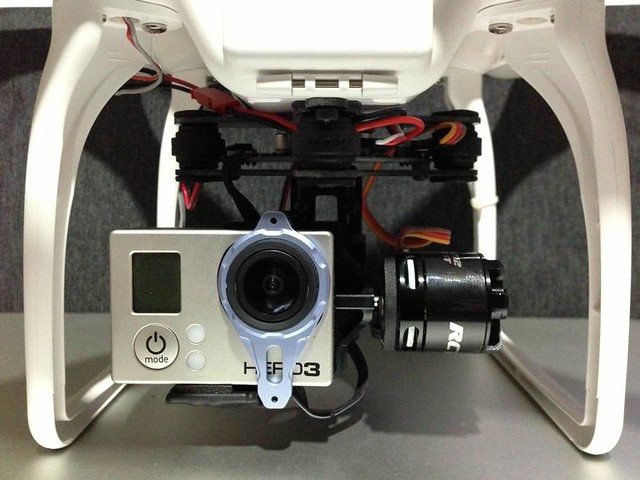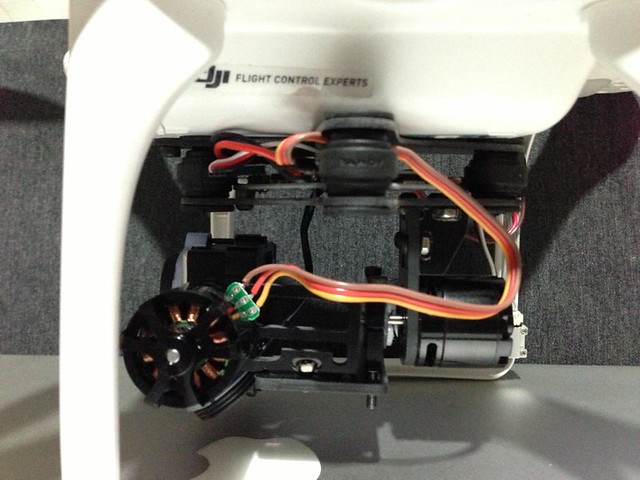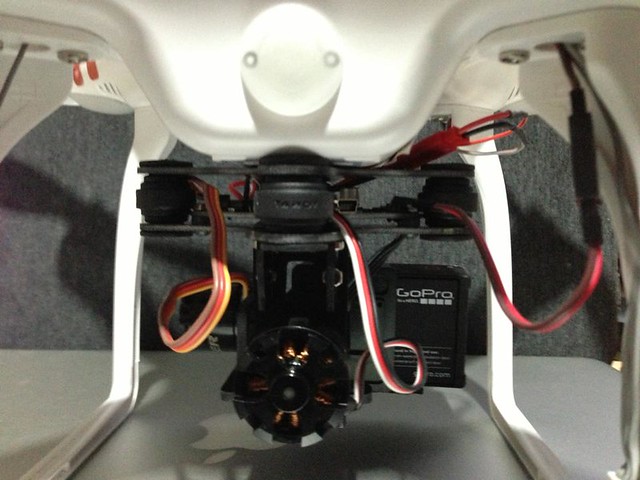So learning from my previous gimbal gamble, I found a more suitable brushless gimbal for the Phantom. I settled on the FG-PH3 brushless gimbal. Search on ebay for "FG-PH3 ARTF 3mm FIBERGLASS 2212 Brushless Motor DD Gimbal"
I had high hopes for this gimbal as it seemed to resolve all my concerns I had from the previous gimbal I had purchased.
It is small and compact, fits cleanly underneath the Phantom without having to modify the landing skids.
It also fits inside the GoProfessional DJI Phantom case without any modifications.
The anti-vibration rubber balls that held the mounting plates were much beefier and less prone to collapse when pressure was put on them.
And lastly, it also came with the v3 Martinez board which I have become quite familiar with.

nice clean fit under the Phantom, power provided by 12v aux line on Phantom.

side profile showing depth of the gimbal and how far forward the Gopro sits.

back view of gimbal, manual pitch cable running from Martinez board up thru rear-right plug on Phantom to Naza-M (same as compass)
When I first attached the gopro to the gimbal, I noticed that it wasn't entirely balanced, it would lean heavy on the roll axis on the motor side, this was easily fixed by loosening 2 screws and sliding the frame that held the Gopro a few milimeters away from the motor. The motors are RCTimer 2212 motors by the way. After balancing the gimbal I immediately loaded the 0.49b r69 firmware. Did a quick flight (at dusk unfortunately) to see how much of an improvement this gimbal design was over the first gimbal
[youtube]http://www.youtube.com/watch?v=IuMLD4lLyhk[/youtube]
Pretty good footage, much better than what I was working with before.
Noticed that there was a new revision update to the 0.49 firmware, r161. Loaded that onto the board the other day and went out to do some recording for a project I am currently working on. Here's a very short clip with some post-processing (speed reduced to 50%, auto levels on colors/contrast, and some stabilization on the very little amount of shake the original clip had)
[youtube]http://www.youtube.com/watch?v=C0_YZvYfrZQ[/youtube]
Overall I am very pleased with the gimbal and am lucky that I had a truly almost-ready-to-fly gimbal that worked well out the box. Some negatives I can think of with this gimbal is that the IMU sensor has no real place to sit on. In the first picture, you can see the IMU sensor is double-sided taped to the underside of the Gopro. Eventually I would like to have the IMU sensor mounted closer to the center of both the roll and pitch axis. There is plenty of room directly behind the Gopro so maybe I'll stick a L-bracket of some sort behind there and put the IMU there.
Another negative, for me at least, is that I do not have a right-angle 90degree usb cable to attach to the Gopro to transfer my videos, I have to unscrew the blue mount to remove the Gopro everytime I want to hook it up to the computer. I have a right-angle cable on the way and I am hoping it will fit without having to remove the Gopro from the gimbal.
Now, back to filming as I am quite excited about this project I am working on
I had high hopes for this gimbal as it seemed to resolve all my concerns I had from the previous gimbal I had purchased.
It is small and compact, fits cleanly underneath the Phantom without having to modify the landing skids.
It also fits inside the GoProfessional DJI Phantom case without any modifications.
The anti-vibration rubber balls that held the mounting plates were much beefier and less prone to collapse when pressure was put on them.
And lastly, it also came with the v3 Martinez board which I have become quite familiar with.

nice clean fit under the Phantom, power provided by 12v aux line on Phantom.

side profile showing depth of the gimbal and how far forward the Gopro sits.

back view of gimbal, manual pitch cable running from Martinez board up thru rear-right plug on Phantom to Naza-M (same as compass)
When I first attached the gopro to the gimbal, I noticed that it wasn't entirely balanced, it would lean heavy on the roll axis on the motor side, this was easily fixed by loosening 2 screws and sliding the frame that held the Gopro a few milimeters away from the motor. The motors are RCTimer 2212 motors by the way. After balancing the gimbal I immediately loaded the 0.49b r69 firmware. Did a quick flight (at dusk unfortunately) to see how much of an improvement this gimbal design was over the first gimbal
[youtube]http://www.youtube.com/watch?v=IuMLD4lLyhk[/youtube]
Pretty good footage, much better than what I was working with before.
Noticed that there was a new revision update to the 0.49 firmware, r161. Loaded that onto the board the other day and went out to do some recording for a project I am currently working on. Here's a very short clip with some post-processing (speed reduced to 50%, auto levels on colors/contrast, and some stabilization on the very little amount of shake the original clip had)
[youtube]http://www.youtube.com/watch?v=C0_YZvYfrZQ[/youtube]
Overall I am very pleased with the gimbal and am lucky that I had a truly almost-ready-to-fly gimbal that worked well out the box. Some negatives I can think of with this gimbal is that the IMU sensor has no real place to sit on. In the first picture, you can see the IMU sensor is double-sided taped to the underside of the Gopro. Eventually I would like to have the IMU sensor mounted closer to the center of both the roll and pitch axis. There is plenty of room directly behind the Gopro so maybe I'll stick a L-bracket of some sort behind there and put the IMU there.
Another negative, for me at least, is that I do not have a right-angle 90degree usb cable to attach to the Gopro to transfer my videos, I have to unscrew the blue mount to remove the Gopro everytime I want to hook it up to the computer. I have a right-angle cable on the way and I am hoping it will fit without having to remove the Gopro from the gimbal.
Now, back to filming as I am quite excited about this project I am working on





